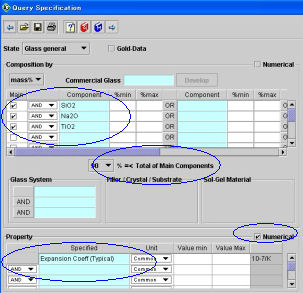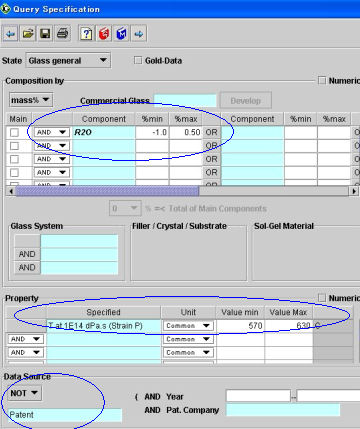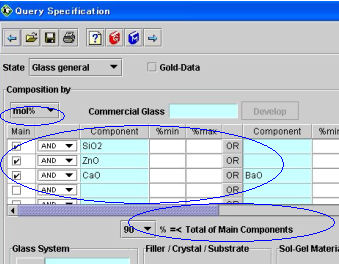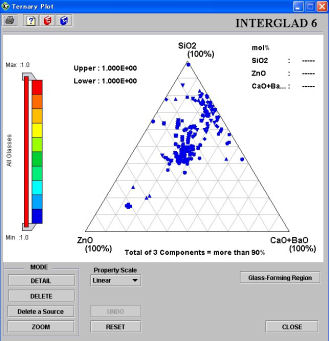(7) Retrieval of glasses of a limited system containing specified components
Here, by way of example, we look at the relationship between the chemical composition of a glass and the thermal expansion coefficient for a system of glasses containing TiO2, Na2O and SiO2 as the main components.

Select 'Glass' in the [State] pull-down menu at the top left of the query specification window, enter 'SiO2' , 'Na2O' and 'TiO2' into the appropriate [Component] cells, check the [Main] checkboxes for the three components, and select '90 %' in the [
Input '1020 Expansion Coeff Typical' in a cell of the [Property] column, and click the [Numerical] checkbox to prevent the retrieval of non-numerical data,*. Press [Search].
Two hundred and sixty-seven glasses from 36 data sources are shown in the retrieved glasses window.
If necessary, particular data can be displayed by pressing the [Informationc] or [Propertyc] buttons, then clicking the [Ternary plot] icon. A dialog box appears. Check the three components 'SiO2' , 'Na2O' and 'TiO2' after clicking the [Component..] button, input '1020 linear expansion coefficient (typical value)' to the Property column, select for instance 90% of the Total min% pull-down menu, and press [OK]. The ternary plot is shown.

 The plotted property values are classified by colors that correspond
to the colors on the vertical slider to the left. The colors change in
accordance with the value of the property. A vertical red bar attached
to the slider connects two pointers. The plotting range is limited by narrowing
the gap between the two pointers and moving the bar up and down the scale.
The nature and contour of the change in thermal expansion with changing
glass composition can be visually monitored.
The plotted property values are classified by colors that correspond
to the colors on the vertical slider to the left. The colors change in
accordance with the value of the property. A vertical red bar attached
to the slider connects two pointers. The plotting range is limited by narrowing
the gap between the two pointers and moving the bar up and down the scale.
The nature and contour of the change in thermal expansion with changing
glass composition can be visually monitored.The property value slider can also be changed to logarithmic scale.
Click on the [Glass-Forming Region] button at the bottom right of the window. The glass-forming region of the 3-component system is shown. The "o" and cross "x"marks represent the recorded data and are related to the glass-forming region. The region of the connecting line side of "o" and that of the connecting line side of "x" represent the glass-forming and non-vitrification regions, respectively. However, because the glass-forming region is related to a sum-total of all components of 100%, when the 'Total of Main Components' specified is less than 100%, the glass-forming region for the glass composition is not necessarily accurate.
Use the following procedure in order to acquire further information about the glasses specified by the o's and x's. Press the [Detail] button at the left of the screen, and click on a plot-point of interest, or right-click on the plot-point first and then click the [Detail] button in the dialog box that appears. The detail window is displayed for the plot-point.
Detailed information about the plot of the linear expansion coefficient can be obtained by a similar procedure. Deletion of single plot-points one by one and simultaneous deletion of all plot-points belonging to the same data source, as well as the zooming operation, are accomplished using the procedures outlined earlier for the X-Y plot window.
 (8) Retrieval of non-alkali glasses
(8) Retrieval of non-alkali glassesBecause the industrial production of glasses containing no alkali is difficult, glasses containing less than 0.5 mass% alkali oxide are usually defined as non-alkali glass. Here, non-alkali glasses having a strain point of 600±30
 are retrieved from data sources other than patents.
are retrieved from data sources other than patents.Select 'Glass general' in the [State] pull-down menu, select 'mass%' in the [Composition Unit] pull-down menu, and then enter 'R2O' (the general reference for alkali oxide), enter '-1' in the [%min] cell and '0.5' in the [%max] cell.
Input '1122 T at 1E14dPa s (Strain Point)' in a [Property] cell, and input '570(
 )' and '630(
)' and '630( )' in the [Value min] and [Value max] cells, respectively, of the same line. Specify 'NOT' in the [Data Source] pull-down menu, input 'Patent' in the [Data Source] cell, and then press [Search]. Seven items are shown. The data sources are eight catalogs and a journal-published paper.
)' in the [Value min] and [Value max] cells, respectively, of the same line. Specify 'NOT' in the [Data Source] pull-down menu, input 'Patent' in the [Data Source] cell, and then press [Search]. Seven items are shown. The data sources are eight catalogs and a journal-published paper.Note: The mark '*' appears in the composition column of retrieved glasses table in the following cases;
(1) The content of any component is not recorded numerically in the data source.
(2) A common name oxide such as R2O or RO is used as a component. In this case, its content is described with '*' after the unit change. Because the molecular weight of the common name oxide is uncertain, the unit of the content cannot be converted to another unit, and only the unit in the data source is available.
(3) A compound of plural oxides such as Na2CO3 or Ca3(PO4)2 is described as a glass component. In this case, beside the compound of plural oxides, its constituents such as Na2O or CaO and P2O5 are described as glass components and their content are '*'.
Note: The property value '*' means that no numerical data is recorded in the data source, or that the data source is displayed along with the data in the graph. (In such cases, it is occasionally also recorded in the Note column as 1 Fig etc.) However, properties registered recently are all collected as numeric data if they are on the graph.
The patent application situation will be investigated for glasses of pseudo-ternary systems, namely SiO2, ZnO, and CaO+BaO.

The [mass%] pull-down menu in the composition section of the query specification window is opened and 'mol%' specified. The [Numerical] checkbox is clicked.
'SiO2' , 'ZnO' and 'CaO' are entered in the [Component] cell, and 'BaO' is entered in the cell to the right of [OR] of the 'CaO' line. After the [Main] checkboxes of those lines are clicked, the minimum value of [Total of Main Components] is specified as 90%.
Moreover, to limit the data to patent data, 'Patent' is specified in the source column. The [Search] button is clicked and 497 data sets (from source number 100) are displayed in the retrieved glasses window.
 When the [
When the [ …] button at the left of the window is clicked, a dialog box appears. 'CaO' is entered in the cell on the left, and 'BaO' in the right cell, and the arithmetic operation sign '+' is selected. Replace 'CaOBaO' to 'CaO+BaO' in the [New Column Name] cell. The [Calculate] button is clicked. The [Ternary plot] icon is now clicked and a dialog box appears. Check the three components 'SiO2' , 'ZnO' and 'CaO+BaO' after clicking the [Component..] button, select 90% of the Total min% pull-down menu, input 'All glasses' to the Property column, and press [OK]. Distribution in the pseudo-ternary systems can be confirmed from the displayed ternary plot of the composition of 497 examples given in patent applications.
…] button at the left of the window is clicked, a dialog box appears. 'CaO' is entered in the cell on the left, and 'BaO' in the right cell, and the arithmetic operation sign '+' is selected. Replace 'CaOBaO' to 'CaO+BaO' in the [New Column Name] cell. The [Calculate] button is clicked. The [Ternary plot] icon is now clicked and a dialog box appears. Check the three components 'SiO2' , 'ZnO' and 'CaO+BaO' after clicking the [Component..] button, select 90% of the Total min% pull-down menu, input 'All glasses' to the Property column, and press [OK]. Distribution in the pseudo-ternary systems can be confirmed from the displayed ternary plot of the composition of 497 examples given in patent applications.Note: Greek characters and others are occasionally replaced by letters of the Roman alphabet, as follows.
α → A, β → B, γ → G, ε → E, κ → X, μ → u, Å → A,
 → C, and so on.
→ C, and so on.Note: When property items are specified in the property column of the query specification window, a '#' sign may appear occasionally in the 'unit' column. This happens when no definition of a property item is fixed for one, even though it is the same property, and so the unit cannot be converted.
The constitution of optical glasses containing Nb2O5 is investigated, using publicly available data.
 Select 'Glass' in the [State] pull-down menu, select 'Nb2O5' in a [Component]
cell of the query specification window, input 30 (mass%) in the adjacent
[%min] cell, then press [Search]. Data on 1246 glasses from 209 data sources
are shown in the retrieved glasses window. Here, the Nb2O5 data can be
sorted by shift-clicking on the list label.
Select 'Glass' in the [State] pull-down menu, select 'Nb2O5' in a [Component]
cell of the query specification window, input 30 (mass%) in the adjacent
[%min] cell, then press [Search]. Data on 1246 glasses from 209 data sources
are shown in the retrieved glasses window. Here, the Nb2O5 data can be
sorted by shift-clicking on the list label. Note that elements for which the number of glasses is at least 54
(20% of 273) are P, B, K, Na, Si, Ti, Ba, As, Li and Sb, in addition to
Nb.
Note that elements for which the number of glasses is at least 54
(20% of 273) are P, B, K, Na, Si, Ti, Ba, As, Li and Sb, in addition to
Nb.Elements with only minor content can be deleted by clicking [Ignore Minor Elements] in the pull-down menu, in order to investigate the major constituents of Nb2O5-containing glasses.
It is found that the only element (present in an oxide form) for which the number of glasses is at least 30 and for which content is at least 20 mass% is phosphorus (P2O5). Phosphorus and silicon are shown when 15 mass% is selected as the lower limit, the same two appear when a 10% minimum is selected, and potassium, sodium, titanium, boron and barium are added as elements for which the number of glasses is at least 30 when the selection is not less than 5 mass%. That is, comparatively speaking, there are a lot of glasses containing P2O5 as a second constituent, followed by those containing SiO2, among the niobate optical glasses.
 Elements present as 10 mass% or less are mostly in constituents such as K2O, Na2O, TiO2, B2O3, and BaO, and those present as 5 mass% or less are mostly in As2O3, Li2O, and Sb2O3. On the other hand, it can be seen that CaO, MgO, SrO, Al2O3, ZnO, ZrO2, and PbO which are used in normal glasses are present in comparatively few.
Elements present as 10 mass% or less are mostly in constituents such as K2O, Na2O, TiO2, B2O3, and BaO, and those present as 5 mass% or less are mostly in As2O3, Li2O, and Sb2O3. On the other hand, it can be seen that CaO, MgO, SrO, Al2O3, ZnO, ZrO2, and PbO which are used in normal glasses are present in comparatively few. Returning to the retrieved glasses window, click on the [X-Y plot] icon, then assign Nb2O5 to the X-axis and the Abbe number to the Y-axis. It will be seen that glasses containing not more than 50 mass% of Nb2O5 are the majority.
| BACK | NEXT |